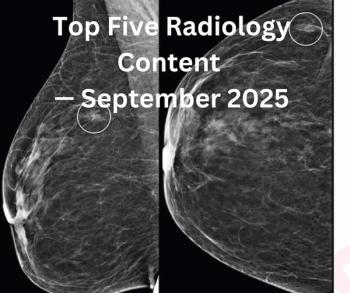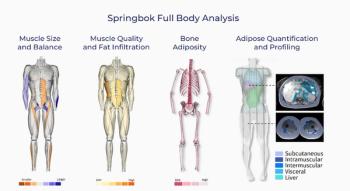
Multislice CT reveals coronary artery anomalies
Coronary artery anomalies are rare, occurring in 0.3% to 1% of the general population. But the clinical importance of these anomalies is significant. Coronary artery anomalies have been found to be a major contributing factor in sudden cardiac deaths in young adults.
Coronary artery anomalies are rare, occurring in 0.3% to 1% of the general population. But the clinical importance of these anomalies is significant. Coronary artery anomalies have been found to be a major contributing factor in sudden cardiac deaths in young adults.1
Systems for defining and classifying these anomalies vary.2 It has been proposed that coronary anatomy observed in more than 1% of a general population should be regarded as normal or a normal variant.2 Anomalies are categorized as significant or insignificant hemodynamically. Hemodynamically significant anomalies should be diagnosed accurately and treated appropriately.
Cross-sectional imaging methods, such as CT or MRI, are considered superior to projection imaging methods, such as catheter coronary angiography, for diagnosing coronary artery anomalies. Coronary CT angiography has attracted considerable attention from both radiologists and cardiologists.3-5 Key parameters for quality CCTA include high temporal resolution and high z-axis spatial resolution. A state-of-the-art dual-source CT system (DSCT), for example, can perform imaging with 83-msec temporal resolution (one quarter the time taken for a single gantry rotation) and 64 x 0.6-mm z-axis spatial resolution.6
A higher incidence of coronary artery anomalies has been reported in patients with congenital heart disease, particularly those with conotruncal malformations.7,8 It is important to consider the surgical implications of such anomalies in this patient group.
CCTA images of coronary artery anomalies found in adults with structurally normal hearts have been reviewed systematically.3-5 Anomalies discovered in patients with congenital heart disease have not.
DSCT has made it possible to visualize coronary arteries in a wider patient population, including young children with high heart rates. CT-based evaluation of coronary artery anomalies in patients with congenital heart disease is now feasible, even during the neonatal period. This capability is crucial because most palliative and corrective surgeries are performed during infancy.
WHAT IS NORMAL?
Normal and variant coronary artery anatomy seen on multislice coronary CTA has been described elsewhere.9 The following additional descriptions may help us to understand arterial anomalies (Figure 1).
The normal origin of the coronary artery arises from the middle portion of each facing sinus. It is termed a pericommisural origin if it arises from the portion adjacent to the commissure of the aortic valve rather than the middle portion of the sinuses. The angle between the origin and the aortic wall typically ranges from 45º to 90º. An angle smaller than 45º and with a slitlike appearance is suggestive of an intramural course. The origin is normally below the sinotubular junction. One above the sinotubular junction is described as a high-takeoff origin.
The normal proximal course of the coronary artery is the shortest distance between the artery and its origin. This implies that an interarterial, retroaortic, or prepulmonic course is abnormal (Figure 2). Major branches do not follow a normal or anomalous septal course, with the exception of septal branches. Myocardial bridging is diagnosed when an abnormal septal course is apparent in the normal coronary artery. This occurs most often in the left anterior descending artery (Figure 3).
Small distal branches of normal coronary artery form a capillary network in the ventricular wall. A direct fistulous communication between the coronary artery and a cardiac chamber or great vessel is abnormal at any level. Normal coronary artery anatomy can be visualized consistently on multislice electrocardiography-synchronized CCTA (Figure 1). Visibility of the origin and proximal segments of the coronary artery is surprisingly high (81.7%) on non-electrocardiography-synchronized cardiac CT. This technique is commonly used for infants and young children with congenital heart disease.10
SIGNIFICANT ANOMALIES
Hemodynamically significant coronary artery anomalies include an anomalous origin from the pulmonary artery, an interarterial course (Figure 2B), myocardial bridging (Figure 3), and coronary artery fistulae.5 These anomalies are clinically significant in both the structurally normal heart and the congenitally malformed heart. They may result in myocardial ischemia, myocardial infarction, or sudden cardiac death.
Anomalies that are hemodynamically benign in patients with a structurally normal heart-for example, high takeoff and multiple ostia-may be important in patients with congenital heart disease who are scheduled for surgery. These anomalies should be regarded as important at coronary artery transfers during arterial switch operations and at ascending aorta clamping for cardiopulmonary bypass. All anomalies, and apparently normal coronary anatomy, may be clinically significant in patients with congenital heart disease.
CONGENITAL HEART DISEASE
Common congenital heart conditions in which coronary artery anomalies are clinically important include transposition of the great arteries, tetralogy of Fallot, truncus arteriosus, and pulmonary atresia with intact ventricular septum.8,11 Surgical techniques used to treat these conditions should be modified according to the type of associated anomaly.
An arterial switch operation is the procedure of choice for biventricular repair. But complete transposition of the great arteries results in the ventriculoarterial connections being reversed (ventriculoarterial discordance). Deoxygenated systemic venous blood entering into systemic arteries can cause cyanosis.
The coronary artery anatomy in patients with complete transposition of the great arteries is highly variable.12 In about 61% of patients, the left coronary artery arises from the left-facing sinus, and the right coronary artery arises from the right-facing sinus of the malpositioned aorta anterior to the pulmonary trunk (d-malposition of great arteries) (Figure 4A).
Coronary artery anomalies associated with significant operative risks include an inverted pattern, single coronary artery, and intramural coronary artery.13 Surgical coronary artery transfer techniques should be modified to prevent kinking or overstretching, which may impair coronary arterial flow. Postoperative evaluation of the coronary artery and myocardial perfusion is important to detect coronary artery stenosis or occlusion. This occurs in 3% to 8% of patients following arterial switching (Figure 4B).8
The fundamental defect associated with tetralogy of Fallot is anterior and superior deviation of the infundibular septum. This results in a malaligned ventricular septal defect, aortic overriding, and right ventricular hypertrophy. Tetralogy of Fallot spans a spectrum of disease. Its most extreme manifestation is pulmonary atresia with ventricular septal defect.
Total surgical correction of the tetralogy of Fallot requires a right ventriculotomy to relieve right ventricular outflow tract obstruction (Figure 5A). The surgical method will need to be modified if a major coronary artery branch crosses the right ventricular outflow tract. Vessels that may do this include prominent conal branches, a left coronary artery arising from the right coronary artery, an accessory left anterior descending artery, and single coronary arteries (Figure 5B).14 Presurgical information on such coronary artery patterns is consequently helpful when planning surgery in patients with tetralogy of Fallot.
Truncus arteriosus, in which a single arterial trunk (via a single truncal valve) supplies the aorta, the pulmonary trunk, and the coronary arteries, is associated with a high prevalence (18%) of coronary artery anomalies.15 These include a single coronary artery, an anomalous origin of the left anterior descending artery from the right coronary artery, a high and posterior origin of the left coronary artery that is just proximal to the pulmonary artery, and a separate origin of the right coronary artery from the opposite sinus.
Cardiac surgeons should worry most about a high and posterior origin of the left coronary artery just proximal to the pulmonary artery. This unfavorable anatomy may result in postoperative coronary artery stenosis or occlusion. Cases of truncus arteriosus can be categorized into three separate types according to the origin pattern of the pulmonary artery. Surgical repair involves division of the pulmonary artery, closure of ventricular septal defects, and creation of a right ventricle-pulmonary artery conduit. A major coronary artery branch traversing the conduit site may cause some difficulty creating the conduit (Figure 5A).
Persistence of right ventricle-coronary artery connections is frequently observed in patients with pulmonary atresia and intact ventricular septa. The right coronary artery and/or the left anterior descending artery are affected most often. Luminal stenosis is seen in the involved coronary arteries in one-third to two-thirds of cases. This is due to myointimal hyperplasia caused by high-pressure, turbulent flow through the coronary artery.
The prevalence of right ventricle-dependent coronary circulation is 8%. Abnormal circulation is a major predictor of poor outcome because it predisposes patients to myocardial ischemia.16 This anomaly may be associated with other congenital heart defects, such as hypoplastic left heart syndrome and/or critical pulmonary stenosis.
Improved surgical technique has helped reduce mortality due to coronary artery anomalies in patients with congenital heart disease. Vigilant imaging evaluation of coronary artery anatomy before and after surgery or intervention is likely to improve patient outcomes further.
State-of-the-art DSCT can provide a fast, accurate evaluation of coronary artery anatomy in patients with congenital heart disease, from neonates to adults, at reasonably low doses of radiation.
References
1. Eckart RE, Scoville SL, Campbell CL, et al. Sudden death in young adults: a 25-year review of autopsies in military recruits. Ann Intern Med 2004;141(1):829-834.
2. Angelini P. Coronary artery anomalies: an entity in search of an identity. Circulation 2007;115(10):1296-1305.
3. Schmitt R, Froehner S, Brunn J, et al. Congenital anomalies of the coronary arteries: imaging with contrast-enhanced, multidetector computed tomography. Europ Radiol 2005;15(6):1110-1121.
4. Datta J, White CS, Gilkeson RC, et al. Anomalous coronary arteries in adults: depiction at multi-detector row CT angiography. Radiology 2005;235(3):812-818.
5. Kim SY, Seo JB, Do KH, et al. Coronary artery anomalies: classification and ECG-gated multi-detector row CT findings with angiographic correlation. Radiographics 2006;26(2): 317-334.
6. Flohr TG, McCollough CH, Bruder H, et al. First performance evaluation of a dual-source CT (DSCT) system. Europ Radiol 2006;16(2):256-268.
7. Koifman B, Egdell R, Somerville J. Prevalence of asymptomatic coronary arterial abnormalities detected by angiography in grown-up patients with congenital heart disease. Cardiol Young 2001;11(6):614-618.
8. Burch GH, Sahn DJ. Congenital coronary artery anomalies: the pediatric perspective. Coron Artery Dis 2001; 12(8):605-616.
9. Kini S, Bis KG, Weaver L. Normal and variant coronary arterial and venous anatomy on high-resolution CT angiography. AJR 2007;188(6):1665-1674.
10. Goo HW, Park IS, Ko JK, et al. Visibility of the origin and proximal course of coronary arteries on non-ECG-gated heart CT in patients with congenital heart disease. Pediatr Radiol 2005;35(8):792-798.
11. Chen SJ, Lin MT, Lee WJ, et al. Coronary artery anatomy in children with congenital heart disease by computed tomography. Int J Cardiol 2007;120(3):363-370.
12. Wernovsky G, Mayer JE Jr, Jonas RA, et al. Factors influencing early and late outcome of the arterial switch operation for transposition of the great arteries. J Thorac Cardiovasc Surg 1995;109(2):289-301.
13. Pasquali SK, Hasselblad V, Li JS, et al. Coronary artery pattern and outcome of arterial switch operation for transposition of the great arteries: a meta-analysis. Circulation 2002;106(20):2575-2580.
14. Need LR, Powell AJ, del Nido P, Geva T. Coronary echocardiography in tetralogy of Fallot: diagnostic accuracy, resource utilization and surgical implications over 13 years. J Am College Cardiol 2000;36(4):1371-1377.
15. Thompson LD, McElhinney DB, Reddy M, et al. Neonatal repair of truncus arteriosus: continuing improvement in outcomes. Ann Thorac Surg 2001;72(2):391-395.
16. Mawson JB. Congenital heart defects and coronary anatomy. Tex Heart Inst J 2002;29 (4):279-289.
Dr. Goo is an associate professor of radiology at the Asan Medical Center of the University of Ulsan College of Medicine in Seoul, Korea.
Newsletter
Stay at the forefront of radiology with the Diagnostic Imaging newsletter, delivering the latest news, clinical insights, and imaging advancements for today’s radiologists.






























